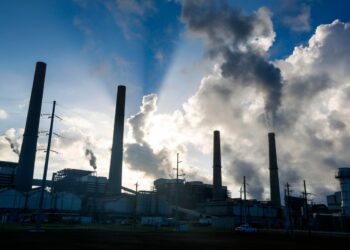Stocks are off to an ugly start for this year. The S&P 500 is expected to see its worst month since March 2020. The drop comes ahead of the Federal Reserve’s interest rate hikes that are expected this year. Tech stocks have been especially hard hit by rising bond yields as investors rotate out of risky growth stocks and into safer assets.
Beyond the market turmoil, however, U.S. economic growth remains strong despite surging inflation. Even as consumers face significant challenges with prices at nearly 40-year highs, GDP growth has rebounded dramatically. What’s more, the labor market continues to recover from the pandemic, with the latest figures showing a diminishing impact from the omicron variant.
Here’s a look at how the stock market and economy fared in January.
10%
The benchmark S&P 500 briefly fell into a correction—down more than 10% from its record highs at the start of the year—as market volatility surged last week. Despite rebounding slightly since then, the S&P 500 has still lost nearly 6% in January—its worst month since March 2020. Experts are warning that the worst may be yet to come, predicting that stocks may continue to fall amid disappointing corporate earnings and the Fed’s tightening monetary policy.
Over 11%
With investors preparing for a rising interest rate environment, government bond yields have jumped: The benchmark 10-year Treasury note sits near two-year highs at 1.78%. Surging rates have put growth stocks, particularly shares of tech companies, under major selling pressure in January. The tech-heavy Nasdaq Composite index has subsequently fallen into correction territory, down more than 11% from its record high last November.
75%
Nearly 75% of stocks in the S&P 500 are down for the month—and over a third have plunged more than 10% since the start of 2022, according to Bloomberg data. What’s more, a bad January doesn’t bode well for stocks going into the rest of the year: Since 1950, the S&P 500 has averaged an annual loss of 1.1% after posting a loss in January, per FactSet.
34%
Oilfield services giant Halliburton was the top stock in the S&P 500 during January, rising over 30%. Like Halliburton, shares of other energy companies have spiked so far in 2022 thanks to oil prices recently surging to nearly $90 per barrel amid global concerns of tight supply and higher demand.
-34%
Vaccine maker Moderna was the worst-performing stock in the S&P 500 this month—down 34% amid growing research suggesting the firm’s booster shot isn’t as effective against the newer omicron variant. After Moderna was one of last year’s top stocks—surging 143% to land the S&P 500’s third-biggest gain in 2021—experts are now questioning whether vaccine sales alone will justify the company’s skyhigh valuation.
6.9%
That’s how much the U.S. economy grew last quarter, blowing past expectations thanks to an uptick in consumer spending, exports and private investments. GDP rebounded strongly in 2021 despite surging inflation, rising 5.7%—its fastest pace since 1984—after a 3.4% decline in 2020, when pandemic shutdowns sent the economy into a recession. The International Monetary Fund last week downgraded its U.S. GDP projection from 5.2% to 4% in 2022, however, citing the ongoing pandemic, rapid inflation, supply chain issues and the Fed’s removal of stimulus.
260,000
That’s the number of jobless claims last week which fell for the first time in a month. Fewer Americans are filing for unemployment benefits, but some economists say a significant number of workers have dropped out of the workforce all together since the pandemic. Last week’s number is down from 290,000 the previous week, when applications hit a three-month high as many workers called in sick. The latest data from the Labor Department, however, shows that the job market is recovering from the impact of the omicron variant amid strong economic growth.
7%
Inflation continues to surge, with consumer prices rising 7% in the twelve months ending in December—marking the highest reading in nearly 40 years. Prices have risen for most consumer goods and services, the government said, with notable gains in shelter, food and used car costs. The Federal Reserve is tightening monetary policy and removing pandemic-era stimulus in a bid to fight skyrocketing prices, announcing last week that it would begin raising interest rates “soon,” starting in March. The central bank has so far forecast three rate hikes in 2022, though Fed Chairman Jerome Powell has said there is “quite a bit of room” to further raise interest rates.










